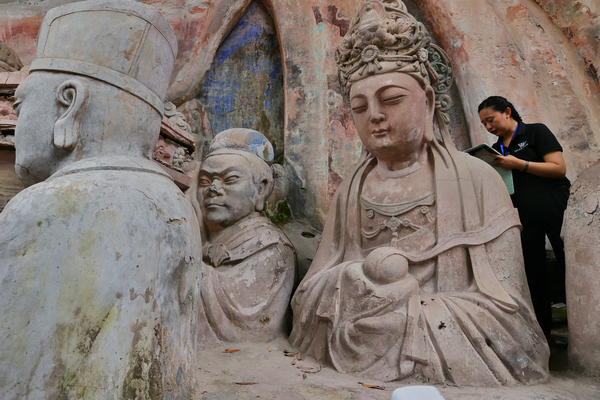

The restoration of the Thousand-Armed Avalokitesvara involved a broad range of disciplines and the participation of numerous experts, and pioneered the restoration of large immovable cultural relics in the country. In 2017, it was honored as a national excellent cultural relic maintenance project.
Today, the statue, restored to its past glory, shimmers and has become a major attraction in the area.
As a result of the feat, Chen has been invited to participate in major restoration projects in Hebei, Gansu and Sichuan provinces.
Her achievements have won her honors, including the National May 1 Labor Medal, one of the highest prizes for working people in China, and a March 8 Red Banner Pacesetter, which is a national honor for outstanding women.
Despite her accomplishments in the field of cultural heritage preservation, Chen remains unsatisfied.
"The simple ailments have already been treated, what remain now are the tough challenges," she says. "This imposes even greater demand for a high level of cultural heritage preservation work."
She believes that it is necessary to enhance the role of technology in cultural heritage preservation, carry out systematic and comprehensive technological protection, and strengthen the development of a skilled workforce.
Chen has played a positive role in training young talent for the protection and restoration of local rock carvings.
Ruan Fanghong, who has been working at the protection center for about six years, says she had heard about Chen before coming to Dazu.
"She helped me restore cultural relics in person, enabling me to experience the importance of being humble in this line of work," Ruan says.
"We must continuously enhance our restoration skills and use technological methods to help prolong the vitality of cultural relics. As members of the next generation, we must shoulder the responsibility of carrying forward traditional Chinese culture," Ruan says.
For Chen, the Yuanjue Cave will remain a focus. To date, preliminary measures such as hydraulic iron frames have been introduced to support the cave roof, while electronic devices have been installed to monitor various parameters of its stability.
Archaeological studies have also been ongoing and three-dimensional scanning has been conducted to preserve the cave's historical information every step of the way.
"In some cases, it takes time, like three to four years, before we can make a judgment and come up with a suitable solution to a problem," Chen explains. "I'm sure there will be many fruitful discoveries further down the line."
Contact the writer at yangfeiyue@chinadaily.com.cn